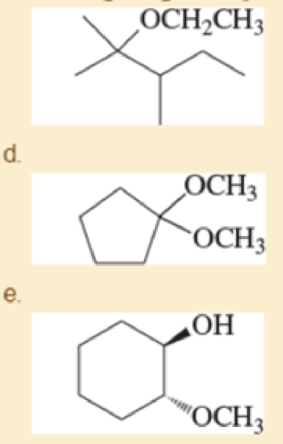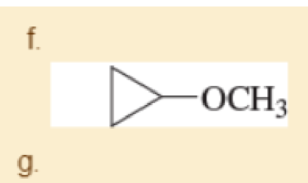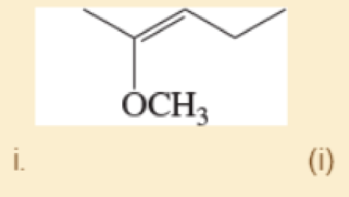
Organic Chemistry (9th Edition)
9th Edition
ISBN: 9780321971371
Author: Leroy G. Wade, Jan W. Simek
Publisher: PEARSON
expand_more
expand_more
format_list_bulleted
Concept explainers
Textbook Question
Chapter 14.3B, Problem 14.4P
Give a common name (when possible) and a systematic name for each compound.
- a. CH3OCH=CH2
- b. CH3CH2OCH(CH3)2
- c. ClCH2CH2OCH3


- h. CH3C ≡ CCH2OCH3

Expert Solution & Answer
Trending nowThis is a popular solution!

Students have asked these similar questions
Rank the following groups in order of decreasing priority.
a. – COOH, – H, – NH2, – OH
b. – H, – CH3, – Cl, – CH2CI
c. -CH2CH3, -CH3, -H, -CH(CH3)2
d. – CH = CH2, – CH3, – C ≡ CH, – H
Is the reaction of 2-butene with HBr regioselective?
a. Is it stereoselective? b. Is it stereospecific?
Which group in each pair is assigned the higher priority?
a. – CH3, – CH2CH3
b. – I, – Br
c. – H, – D
d. – CH2Br, – CH2CH2Br
e. – CH2CH2Cl, – CH2CH(CH3)2
f. – CH2OH, – CHO
Chapter 14 Solutions
Organic Chemistry (9th Edition)
Ch. 14.2C - Rank the given solvents in decreasing order of...Ch. 14.2D - Prob. 14.2PCh. 14.2D - In the presence of 18-crown-6, potassium...Ch. 14.3B - Give a common name (when possible) and a...Ch. 14.3C - Prob. 14.5PCh. 14.3C - Name the following heterocyclic ethers.Ch. 14.4 - Propose a fragmentation to account for each...Ch. 14.5 - Prob. 14.8PCh. 14.5 - Prob. 14.9PCh. 14.6 - Prob. 14.10P
Ch. 14.7 - Explain why bimolecular condensation is a poor...Ch. 14.7 - Prob. 14.12PCh. 14.7 - Prob. 14.13PCh. 14.8 - Prob. 14.14PCh. 14.8 - Prob. 14.15PCh. 14.8 - Prob. 14.16PCh. 14.10A - Prob. 14.17PCh. 14.10A - Prob. 14.18PCh. 14.10B - Prob. 14.19PCh. 14.11B - Show how you would accomplish the following...Ch. 14.11B - Prob. 14.21PCh. 14.12 - Prob. 14.22PCh. 14.12 - Prob. 14.23PCh. 14.12 - Prob. 14.24PCh. 14.13 - Prob. 14.25PCh. 14.13 - Prob. 14.26PCh. 14.14 - Prob. 14.27PCh. 14.15 - Give the expected products of the following...Ch. 14 - Write structural formulas for the following...Ch. 14 - Give common names for the following compounds. a....Ch. 14 - Give IUPAC names for the following compounds. a....Ch. 14 - Glycerol (propane-1,2,3-triol) is a viscous syrup...Ch. 14 - Prob. 14.33SPCh. 14 - Show how you would make the following ethers,...Ch. 14 - (A true story.) An inexperienced graduate student...Ch. 14 - Prob. 14.36SPCh. 14 - a. Show how you would synthesize the pure (R)...Ch. 14 - a. Predict the values of m/z and the structures of...Ch. 14 - The following reaction resembles the...Ch. 14 - Prob. 14.40SPCh. 14 - Prob. 14.41SPCh. 14 - Prob. 14.42SPCh. 14 - Give the structures of the intermediates...Ch. 14 - Prob. 14.44SPCh. 14 - Show how you would synthesize the following ethers...Ch. 14 - Prob. 14.46SPCh. 14 - Prob. 14.47SPCh. 14 - Prob. 14.48SPCh. 14 - An acid-catalyzed reaction was carried out using...Ch. 14 - Propylene oxide is a chiral molecule. Hydrolysis...Ch. 14 - Prob. 14.51SPCh. 14 - Prob. 14.52SPCh. 14 - Prob. 14.53SPCh. 14 - Prob. 14.54SPCh. 14 - In 2012, a group led by Professor Masayuki Satake...
Knowledge Booster
Learn more about
Need a deep-dive on the concept behind this application? Look no further. Learn more about this topic, chemistry and related others by exploring similar questions and additional content below.Similar questions
- Which compound will give a positive test with Br2/CH3Cl, a positive test with HCl/ZnCl2, and a positive test with CrO3/H2SO4?arrow_forwardIndicate whether each statement is true or false. (a) Butanecontains carbons that are sp2 hybridized. (b) Cyclohexaneis another name for benzene. (c) The isopropyl group containsthree sp3-hybridized carbons. (d) Olefin is anothername for alkyne.arrow_forwardDetermine the reagent that could best differentiate the two compounds given. A. ZnCl2 B. NaOH C. FeCl3 D. KMnO4arrow_forward
- What is each compound’s systematic name? 1. (CH3)3CCH2CH2CH2CH(CH3)2 2. BrCH2CH2CH2CH2CH2NHCH2CH3 3.(CH3CH2)4C 4.CH3OCH2CH2CH2OCH3arrow_forwardHow many chirality centers exist on this molecule? What is the absolute configuration of the primary alcohol in this structure? How many lone pairs are on the structure? How many sp2 hybridized atoms are on the structure?arrow_forwardLabel them based on the type of stereoisomerism they exhibit in. OPTICAL. NEITHER OPTICAL OR GEOMETRIC GEOMETRIC CH3CH(CBr3)CH2CH2CH3 CHCI=CHCH2CI CH3CH(CBr3)CH2CH3 CF2=CI2 CHBr=CHCH2Brarrow_forward
- Which member of each pair is more soluble in water? Why?(a) CH₃CH₂OCH₂CH₃(l) or CH₃CH₂OCH₃(g)(b) CH₂Cl₂(l) or CCl₄(l)arrow_forwardWhen (CH3CH2)3CBr is added to CH3OH at room temperature, the major product is (CH3O)C(CH2CH3)3 and a minor product is CH3CH=C(CH2CH3)2. Propose a mechanism for the product that is formed by the substitution reaction. Use curved arrows to show the movement of electrons.arrow_forwardFrom the given two compounds in the image, which reagents would differentiate the pair? a. Br2 in CH2Cl2 b. CrO3, H2SO4, acetone c. concentrated HCl with ZnCl2 d. aqueous FeCl3 e. aqueous NAHCO3 f. ammoniacal AgNo3arrow_forward
arrow_back_ios
SEE MORE QUESTIONS
arrow_forward_ios
Recommended textbooks for you

Nomenclature: Crash Course Chemistry #44; Author: CrashCourse;https://www.youtube.com/watch?v=U7wavimfNFE;License: Standard YouTube License, CC-BY